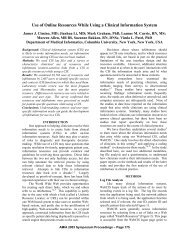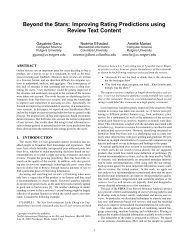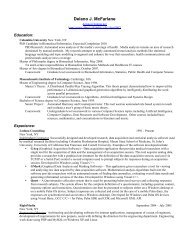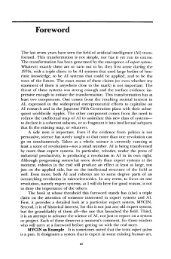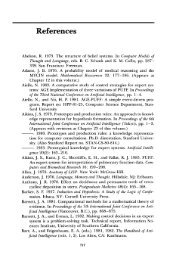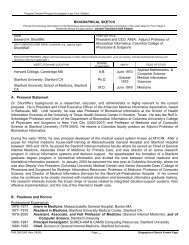Chapter 1 - People
Chapter 1 - People
Chapter 1 - People
Create successful ePaper yourself
Turn your PDF publications into a flip-book with our unique Google optimized e-Paper software.
In the early stages of the development of any science different menconfronting the same range of phenomena, but not usually all the sameparticular phenomena, describe and interpret them in different ways. What issurprising, and perhaps also unique in its degree to the fields we call science, isthat such initial divergences should ever largely disappear.T. S. Kuhn, The Structure ofScientific Revolutions (InternationalEncyclopedia of Unified Science,vol. II, no. 2). Chicago:University of Chicago Press, 1962.The philosopher’s treatment of a question is like the treatment of an illness.L. Wittgenstein, PhilosophicalInvestigations, para. 255 (trans.G. E. M. Anscombe). New York:Macmillan, 1953.Every one then who hears these words of mine and does them will be like awise man who built his house upon the rock; and the rain fell, and the floodscame, and the winds blew and beat upon that house, but it did not fall, becauseit had been founded on the rock. And every one who hears these words of mineand does not do them will be like a foolish man who built his house upon thesand; and the rain fell, and the floods came, and the winds blew and beat againstthat house, and it fell; and great was the fall of it.Matthew 7:24-27(Revised Standard Version)
BackgroundPART ONE
1The Context of the MYCINExperimentsArtificial Intelligence (AI) is that branch of computer science dealing withsymbolic, nonalgorithmic methods of problem solving. Several aspects ofthis statement are important for understanding MYCIN and the issuesdiscussed in this book. First, most uses of computers over the last 40 yearshave been in numerical or data-processing applications, but most of a person’sknowledge of a subject like medicine is not mathematical or quantitative.It is symbolic knowledge, and it is used in a variety of ways in problemsolving. Also, the problem-solving methods themselves are usually notmathematical or data-processing procedures but qualitative reasoning techniquesthat relate items through judgmental rules, or heuristics, as well asthrough theoretical laws and definitions. An algorithm is a procedure thatis guaranteed either to find the correct solution to a problem in a finitetime or to tell you there is no solution. For example, an algorithm foropening a safe with three dials is to set the dials on every combination ofnumbers and try the lock after each one. Heuristic methods, on the otherhand, are not guaranteed to work, but will often find solutions in muchshorter times than will exhaustive trial and error or other algorithms. Forthe example of the safe, one heuristic is to listen for tumblers to drop intoplace. Few problems in medicine have algorithmic solutions that are bothpractical and valid. Physicians are forced to reason about an illness usingjudgmental rules and empirical associations along with definitive truths ofphysiology.MYCIN is an expert system (Duda and Shortliffe, 1983). By thatmean that it is an AI program designed (a) to provide expert-level solutionsto complex problems, (b) to be understandable, and (c) to be flexibleenough to accommodate new knowledge easily. Because we have designedMYCIN to provide advice through a consultative dialogue, we sometimesrefer to it as a consultation system.There are two main parts to an expert system like MYCIN: a knowledgebase and an inference mechanism, or engine (Figure l-l). In addition,there are often subprograms designed to facilitate interaction with users,
4 The Context of the MYCIN Experiments=~of new caseUSERIDescriptionAdvice &ExplanationUserinterfaceEXPERT SYSTEMqp~ Inference Enginetqp_~ Knowledge [ BaseFIGURE 1-1 Major parts of an expert system. Arrows indicateinformation flow.to help build a knowledge base, to explain a line of reasoning, and so forth.The knowledge base is the program’s store of facts and associations it"knows" about a subject area such as medicine. A critical design decisionis how such knowledge is to be represented within the program. There aremany choices, in general. For MYCIN, we chose to represent knowledgemostly as conditional statements, or rules, of the following form:IF: There is evidence that A and B are true,THEN: Conclude there is evidence that C is true.This form is often abbreviated to one of the following:If A and B, then CA& B--*CWe refer to the antecedent of a rule as the premise or left-hand side (LHS)and to the consequent as the action or right-hand side (RHS).The inference mechanism can take many forms. We often speak ofthe control structure or control of inference to reflect the [’act that thereare different controlling strategies for the system. For example, a set ofrules may be chained together, as in this example:If A, then B (Rule 1)If B, then C (Rule 2)A.’.C(Data)(Conclusion)
The Context of the MYCIN Experiments 5This is sometimes called forward chaining, or data-directed inference, becausethe data that are known (in this case A) drive the inferences fromleft to right in rules, with rules chaining together to deduce a conclusion(C).MYCIN primarily uses backward chaining, or a goal-directed controlstrategy. The deductive validity of the argument is established in the sameway, but the system’s behavior is quite different. In goal-directed reasoninga system starts with a statement of the goal to achieve and works "backward"through inference rules, i.e., from right to left, to find the data thatestablish that goal, for example:Find out about C (Goal)If B, then C (Rule 1)If A, then B (Rule 2).’.If A, then C(Implicit rule)Question: Is A true?(Data)Since there are many rule chains and many pieces of data about which thesystem needs to inquire, we sometimes say that MYCIN is an evidencegatheringprogram.The whole expert system is used to perform a task, in MYCIN’s caseto provide diagnostic and therapeutic advice about a patient with an infectionas described in Section 1.2. We sometimes refer to the whole system,shown in Figure 1-1, as the performance system to contrast it with othersubsystems not so directly related to giving advice. MYCIN contains anexplanation subsystem, for example, which explains the reasoning of theperformance system (see Part Six).Several of the chapters in this book deal with the problems of constructinga performance system in the first place. We have experimentedwith different kinds of software tools that aid in the construction of a newsystem, mostly by helping with the formulation and understanding of anew knowledge base. We refer to the process of mapping an expert’s knowledgeinto a program’s knowledge base as knowledge engineering. 1 The intendedusers of these kinds of tools are either (a) the so-called knowledgeengineers who help an expert formulate and represent domain-specificknowledge for the performance system or (b) the experts themselves. AI-1The term knowledgengineering was, to the best of our knowledge, coined by Edward Feigenbaumafter Donald Michie’s phrase epistemological engineering. Like the phrases expert systemand knowledge-based system, however, it did not come into general use until about 1975. Formore discussion of expert systems, see Buchanan and Duda (1983).
6 The Context of the MYCIN Experimentsthough either group might also run the performance system to test it,neither overlaps with the intended routine users of the performance system.Our model is that engineers help experts build a system that otherslater use to get advice. Elaborating on the previous diagrams, we show thismodel in Figure 1-2.Choice of Programming LanguageLISP has been the programming language of choice for AI programs fornearly two decades (McCarthy et al., 1962). It is a symbol manipulationlanguage of extreme flexibility based on a small number of simple constructs.2 We are often asked why we chose LISP for work on MYCIN, soa brief answer is included here. Above all, we needed a language andprogramming environment that would allow rapid modification and testingand in which it was easy and natural to separate medical rules in theknowledge base from the inference procedures that use the rules. LISP isan interpretive language and thus does not require that programs be recompiledafter they have been modified in order to test them. Moreover,LISP removes the distinction between programs and data and thus allowsus to use rules as parts of the program and to examine and edit them as datastructures. The editing and debugging facilities of Interlisp also aided ourresearch greatly.Successful AI programs have been written in many languages. Untilrecently LISP was considered to be too slow and too large for importantapplications. Thus there were reasons to consider other languages. But fora research effort, such as this one, we were much more concerned withsaving days during program development than with saving seconds at runtime. We needed the flexibility that LISP offered. When Interlisp becameavailable, we began using it because it promised still more conveniencethan other versions. Now that additional tools, such as EMYCIN, have beenbuilt on top of Interlisp, more savings can be realized by building newsystems using those tools (when appropriate) than by building from thebase-level LISP system. At the time we began work on MYCIN, however,we had no choice.1.1Historical Perspective on MYCINAs best as we can tell, production rules were brought into artificial intelligence(AI) by Allen Newell, who had seen their power and simplicitydemonstrated in Robert Floyd’s work on formal languages and compilers’)See Winston and Horn ( 1981), Charniak et al. (1980), and Allen (1978) for more informationabout the language itself.
~tXLU:I’-UAO.e-0vJ~ o
8 The Context of the MYCIN Experiments(Floyd, 1961) at Carnegie-Mellon University. Newell saw ih productionsystems an elegant formalism for psychological modeling, a theme stillpursued at Carnegie-Mellon University and elsewhere. Through conversationsbetween Newell and himself at Stanford in the 1960s (see Newell,1966), Edward Feigenbaum began advocating the use of production rulesto encode domain-specific knowledge in DENDRAL. Don Watermanpicked up on the suggestion, but decided to work with rules and heuristicsof the game of poker (Waterman, 1970) rather than of mass spectrometry.His success, and Feigenbaum’s continued advocacy, led to recoding muchof DENDRAUs knowledge into rules (Lindsay et al., 1980).The DENDRAL program was the first AI program to emphasize thepower of specialized knowledge over generalized problem-solving methods(see Feigenbaum et al., 1971). It was started in the mid-1960s by JoshuaLederberg and Feigenbaum as an investigation of the use of AI techniquesfor hypothesis formation. It constructed explanations of empirical data inorganic chemistry, specifically, explanations of analytic data about the molecularstructure of an unknown organic chemical compound. "~ By the mid-1970s there were several large programs, collectively called DENDRAL,which interacted to help organic chemists elucidate molecular structures.The programs are knowledge-intensive; that is, they require very specializedknowledge of chemistry in order to produce plausible explanations ofthe data. Thus a major concern in research on DENDRAL was how torepresent specialized knowledge of a domain like chemistry so that a computerprogram could use it for complex problem solving.MYCIN was an outgrowth of DENDRAL in the sense that many ofthe lessons learned in the construction of DENDRAL were used in thedesign and implementation of MYCIN. Foremost among these was thenewfound power of production rules, as discussed in <strong>Chapter</strong> 2. The seniormembers of the DENDRAL team, Lederberg and Feigenhaum, had convincedthemselves and Bruce Buchanan that the AI ideas that made DEN-DRAL work could be applied to a problem of medical import. At aboutthat time, Edward Shortliff’e had just discovered AI as a medical studentenrolled in a Computer Science Department course entitled "Models ofThought Processes," taught at the time by Jerome Feldman. Also, StanleyCohen, then Chief of Clinical Pharmacology at the Stanford UniversityMedical School, had been working on a medical computing project, theMEDIPHOR drug interaction warning system (Cohen et al., 1974). He hadsought Buchanan’s involvement and had also just accepted Shortliffe as aresearch assistant on the project. In addition, the late George Forsythe,then Chairman of the Computer Science Department, was strongly supportiveof this kind of interdisciplinary research project and encouraged3Even more specifically, the data abom the unknown compound were data from a massspectrometer, an instrument that bombards a small sample uf a compound with high-energyelectrons and produces data on the resulting fragments.
Historical Perspective on MYCIN 9Shortliffe in his efforts to obtain formal training in the field. Thus thescene was set for a collaborative effort involving Cohen, Buchanan, andShortliffe--an effort that ultimately grew into Shortliffe’s dissertation.After six months of collaborative effort on MEDIPHOR, our discussionsbegan to focus on a computer program that would monitor physicians’prescriptions for antibiotics and generate warnings on inappropriateprescriptions in the same way that MEDIPHOR produced warnings regardingpotential drug-drug interactions. Such a program would haveneeded to access data bases on three Stanford computers: the pharmacy,clinical laboratory, and bacteriology systems. It would also have requiredconsiderable knowledge about the general and specific conditions thatmake one antibiotic, or combination of antibiotics, a better choice thananother. Cohen interested Thomas Merigan, Chief of the Infectious DiseaseDivision at Stanford, in lending both his expertise and that of StantonAxline, a physician in his division. In discussing this new kind of monitoringsystem, however, we quickly realized that it would require much moremedical knowledge than had been the case for MEDIPHOR. Before asystem could monitor for inappropriate therapeutic decisions, it wouldneed to be an "expert" in the field of antimicrobial selection. Thus, withminor modifications for direct data entry from a terminal rather than frompatient data bases, a monitoring system could be modified to provide consultationsto physicians. Another appeal of focusing on an interactive systemwas that it provided us with a short-term means to avoid the difficultyof linking three computers together to provide data to a monitoring system.Thus our concept of a computer-based consultant was born, and webegan to model MYCIN after infectious disease consultants. This modelalso conformed with Cohen’s strong belief that a computer-based aid formedical decision making should suggest therapy as well as diagnosis.Shortliffe synthesized medical knowledge from Cohen and Axline andAI ideas from Buchanan and Cordell Green. Green suggested using Interlisp(then known as BBN-LISP), which was running at SRI International(then Stanford Research Institute) but was not yet available at the university.Conversations with him also led to the idea of using Carbonell’s program,SCHOLAR (Carbonell, 1970a), as a model for MYCIN. SCHOLARrepresented facts about the geography of South America in a large semanticnetwork and answered questions by making inferences over thenet. However, this model was not well enough developed for us to see howa long dialogue with a physician could be focused on one lin e of reasoningat a time. We also found it difficult to construct semantic networks for theill-structured knowledge of infectious disease. We turned instead to a rulebasedapproach that Cohen and Axline found easier to understand, particularlybecause chained rules led to lines of reasoning that they couldunderstand and critique.One important reason for the success of our early efforts was Shortliffe’sability to provide quickly a working prototype program that wouldshow Cohen and Axline the consequences of the rules they had stated at
10 The Context of the MYCIN Experimentseach meeting. The modularity of the rules was an important benefit inproviding rapid feedback on changes. Focusing early on a working programnot only kept the experts interested but also allowed us to design theemerging program in response to real problems instead of trying to imaginethe shape of the problems entirely in advance of their manifestationsin context.Green recommended hiring Carli Scott as our first full-time employee,and the MYCIN research began to take shape as a coordinated project.Axline subsequently enlisted help from infectious disease fellows to complementthe expertise of" Cohen’s clinical pharmacology fellow. Graduatestudents from the Computer Science Department were also attracted tothe work, partly because of" its social relevance and partly because it wasnew and exciting. Randall Davis, for example, had been working on visionunderstanding at the Stanford AI Lab and had been accepted for medicalschool when he heard about MYCIN and decided to invest his researchtalents with us.In our first grant application (October, 1973), we described the goalsof the project.For the past year and a half the Divisions of Clinical Pharmacology andInfectious Disease plus members of the Department of Computer Sciencehave collaborated on initial development of a computer-based system (termedMYCIN) that will be capable of using both clinical data and judgmental decisionsregarding infectious disease therapy. The proposed research involvesdevelopment and acceptable implementation of the following:A. CONSULTATION PROGRAM. The central component of the MY-CIN system is an interactive computer program to provide physicians withconsultative advice regarding an appropriate choice of antimicrobial therapyas determined from data available from the microbiology and clinical chemistrylaboratories and from direct clinical observations entered by the physicianin response to computer-generated questions;B. INTERACTIVE EXPLANATION CAPABILITIES. Another importantcomponent of the system permits the consultation program to explainits knowledge of infectious disease therapy and to.justify specific therapeuticrecommendations;C. COMPUTER ACQUISITION OF JUDGMENTAL KNOWLEDGE.The third aspect of this work seeks to permit experts in the field of infectiousdisease therapy to teach the MYCIN system the therapeutic decision rulesthat they find useful in their clinical practice.The submission of" our initial grant application encouraged us to choose aname for the project on which we had already been working for two years.After [’ailing to find a suitable acronym, we selected the name MYCIN atAxline’s suggestion. This name is simply the common suffix associated withmany antimicrobial agents.Although we were aiming at a program that would help physicians,we also realized that there were many computer science problems with
Historical Perspective on MYCIN 111960’SJ1970’SI I(QA) (Inference)I(Evaluation)CONGEN¯ Meta-DENDRALSU/X1980’SBAOBABI GUIDON I1NEOMYCINONCOCINI TEIRESIASI~"’FFI I II SACONI I’:l I CENTAUREMYCIN I~, GRAVIDAWHEEZE CLOTDARTJFIGURE 1-3 HPP programs relating to MYCIN. (Programnames in boxes were Ph.D. dissertation research programs.)which we had to grapple. No other AI program, including DENDRAL,had been built using so much domain-specific knowledge so clearly separatedfrom the inference procedures.A schematic review of the history of the work on MYCIN and relatedprojects is shown in Figure 1-3. MYCIN was one of several projects in theStanford Heuristic Programming Project (HPP); others were DENDRAL,CONGEN, Meta-DENDRAL, and SU/X. 4 There was much interactiontLater renamed IqASI)/SIAP (Nii and Feigenbaum, 1978; Nii et al., 1982).
12 The Context of the MYCIN Experimentsamong the individuals working in HPP that is not shown in this simplifieddiagram, of course. Within the MYCIN project individuals were workingon several nearly separable subprojects, some of which are shown: QuestionAnswering (QA), Inference (including certainty factors, or CF’s,the therapy recommendation code), Explanation, Evaluation, and KnowledgeAcquisition. These subprojects formed the basis of several of theexperiments reported in this volume. All were well-fbcused projects sincewe were undertaking them partly to improve the knowledge base and theperformance of MYCIN. Figure 1-3 shows roughly the chronology ofwork; however, in the organization of this book chronology is not emphasized.Ancient HistoryJaynes (1976) refers to a collection of 20,000-30,000 Babylonian tablets,about 20% of which contain sets of production rules ("omens") for governingeveryday affairs. 5 These were already written and catalogued byabout 650 B.c. He describes the form of each entry as "an if-clause orprotasis followed by a then-clause or apodosis." For example,"If a horse enters a man’s house and bites either an ass or a man,the owner of the house will die and his household will be scattered.""If a man unwittingly treads on a lizard and kills it,he will prevail over his adversary."Included in these are medical rules, correlating symptoms with prognoses.According to one of Jaynes’ sources (Wilson, 1956; 1962), thesetablets of scientific teachings were catalogued by subject matter around 700B.C. Among the left-hand sides quoted from the medical tablets are thefollowing (Wilson, 1956):"If, after a day’s illness, he begins to suffer from headache ...""If, at the onset of his illness, he had prickly heat...""If he is hot (in one place) and cold (in another) ."If the affected area is clammy with sweat..."Each clause is catalogued as appearing in 60-150 entries on the tablets.One right-hand side for the medical rules cited by Wilson is the following:"... he will die suddenly."5We are indebted to James Bennett for pointing out this reference.
MYCIN’s Task Domain--Antimicrobial Selection 13Thus we see that large collections of simple rules were used for medicaldiagnosis long before MYCIN and that some thought had been given tothe 6 organization of the knowledge base.1.2MYCIN’s Task DomainmAntimicrobialSelectionBecause a basic understanding of MYCIN’s task domain is important forunderstanding much of what follows, we include here a brief descriptionof 7 infectious disease diagnosis and therapy.1.2.1 The Nature of the Decision ProblemAn antimicrobial agent is any drug designed to kill bacteria or to arresttheir growth. Thus the selection of antimicrobial therapy refers to theproblem of" choosing an agent (or combination of agents) for use in treatinga patient with a bacterial infection. The terms antimicrobial and antibioticare often used interchangeably, even though the latter actually refers toany one of" a number of drugs that are isolated as naturally occurringproducts of bacteria or fungi. Thus the well-known penicillin mold is thesource of" an antibiotic, penicillin, that is used as an antimicrobial. Someantibiotics are too toxic for use in treating infectious diseases but are stillused in research laboratories (e.g., dactinomycin) or in cancer chemotherapy(e.g., daunomycin). Furthermore, some antimicrobials (such as the sulfonamides)are synthetic drugs and are therefore not antibiotics. Thereare also semisynthetic antibiotics (e.g., methicillin) that are producedchemical laboratories by manipulating a naturally occurring antibiotic molecule.In writing about MYCIN we have tended not to rely on this formaldistinction between antimicrobial and antibiotic and have used the termsas though they were synonymous.Antimicrobial selection would be a trivial problem if there were a singlenontoxic agent effective against all bacteria capable of causing human disease.However, drugs that are highly useful against certain organisms areoften not the most effective against others. The identity (genus) of theorganism causing an infection is therefore an important clue for deciding~iThe fact that the rules on the tablets were themselves indexed by premise clauses wouldsuggest that they were used in data-directed fashion. Yet the global organization of rules ontablets was by suk~iect matter, so that medical rules were together, house-building rules together,and so on. This "big switch" organization of the knowledge base is an early instanceof using rule groups to focus the attention of the problem solver, a pressing problem, especiallyill large, data-directed systemsuch as the Babylonian omens.7This section is based on a similar discussion by Shortliffe (1974).
14 The Context of the MYCIN Experimentswhat drugs are apt to be beneficial for the patient. Initially, MYCIN didnot consider infections caused by viruses or pathogenic fungi, but sincethese other kinds of organisms are particularly significant as causes ofmeningitis, they were later added when we began to work with that domain.Selection of therapy is a four-part decision process. First, the physicianmust decide whether or not the patient has a significant infection requiringtreatment. If there is significant disease, the organism must be identifiedor the range of possible identities must be inferred. The third step is toselect a set of drugs that may be appropriate. Finally, the most appropriatedrug or combination of drugs must be selected from the list of possibilities.Each step in this decision process is described below.Is the Infection Significant?The human body is normally populated by a wide variety of bacteria.Organisms can invariably be cultured from samples taken from a patient’sskin, throat, or stool. These normal flora are not associated with disease inmost patients and are, in fact, often important to the body’s homeostaticbalance. The isolation of bacteria from a patient is therefore not presumptiveevidence of significant infectious disease.Another complication is the possibility that samples obtained fromnormally sterile sites (such as the blood, cerebrospinal fluid, or urinarytract) will be contaminated with external organisms either during the collectionprocess itself or in the microbiology laboratory where the culturesare grown. It is therefore often wise to obtain several samples and to seehow many contain organisms that may be associated with significant disease.Because the patient does have a normal bacterial flora and contaminationof cultures may occur, determination of the significance of an infectionis usually based on clinical criteria. Does the patient have a fever?Is he or she coughing up sputum filled with bacteria? Does the patienthave skin or blood findings suggestive of serious infection? Is his or herchest x-ray normal? Does the patient have pain or inflammation? Theseand similar questions allow the physician to judge the seriousness of thepatient’s condition and often demonstrate why the possibility of infectionwas considered in the first place.What Is the Organism’s Identity?There are several laboratory tests that allow an organism to be identified.The physician first obtains a sample from the site of suspected infection(e.g., a blood sample, an aspirate from an abscess, a throat swabbing, orurine specimen) and sends it to the microbiology laboratory for culture.
MYCIN’s Task Domain--Antimicrobial Selection 15There the technicians first attempt to grow organisms from the sample onan appropriate nutritional medium. Early evidence of growth may allowthem to report the morphological and staining characteristics of the organism.However, complete testing of the organism to determine a definiteidentity usually requires 24-48 hours or more.The problem with this identification process is that the patient may beso ill at tile time when the culture is first obtained that the physician cannotwait two days before beginning antimicrobial therapy. Early data regardingthe organism’s staining characteristics, morphology, growth conformation,and ability to grow with or without oxygen may therefore become cruciallyimportant for narrowing down the range of possible identities. Furthermore,historical infbrmation about the patient and details regarding his orher clinical status may provide additional useful clues as to the organism’sidentity.What Are the PotentiallyUseful Drugs?Even once the identity of an organism is known with certainty, its rangeof antimicrobial sensitivities may be unknown. For example, although aPseudomonas is usually sensitive to gentamicin, an increasing number ofgentamicin-resistant Pseudomonae are being isolated. For this reason themicrobiology technicians will often run in vitro sensitivity tests on an organismthey are growing, exposing the bacterium to several commonlyused antimicrobial agents. This sensitivity information is reported to thephysician so that he or she will know those drugs that are likely to beeffective in vivo (i.e., in the patient).Sensitivity data do not become available until one or two days afterthe culture is obtained, however. The physician must therefore often selecta drug on the basis of the list of possible identities plus the antimicrobialagents that are statistically likely to be effective against each of the identities.These statistical data are available from many hospital laboratories(e.g., 82% of E. coli isolated at Stanford Hospital are sensitive in vitro togentamicin), although, in practice, physicians seldom use the probabilisticinformation except in a rather intuitive sense (e.g., "Most of the E. coliinfections I have treated recently have responded to gentamicin.").Which Drug Is Best for This Patient?Once a list of drugs that may be useful has been considered, the bestregimen is selected on the basis of a variety of factors. These include thelikelihood that the drug will be effective against the organism, as well as anumber of clinical considerations. For example, it is important to knowwhether or not the patient has any drug allergies and whether or not thedrug is contraindicated because of age, sex, or kidney status. If the patient
16 The Context of the MYCIN Experimentshas meningitis or brain involvement, whether or not the drug crosses theblood-brain barrier is an important question. Since some drugs can begiven only orally, intravenously (IV), or intramuscularly (IM), the desiredroute of administration may become an important consideration. The severityof the patient’s disease may also be important, particularly for thosedrugs whose use is restricted on ecological grounds or which are particularlylikely to cause toxic complications. Furthermore, as the patient’s clinicalstatus varies over time and more definitive information becomes availablefrom the microbiology laboratory, it may be wise to change the drugof choice or to modify the recommended dosage.1.2.2 Evidence That Assistance Is NeededThe "antimicrobial revolution" began with the introduction of the sulfonamidesin the 1930s and penicillin in 1943. The beneficial effects that theseand subsequent drugs have had on humanity cannot be overstated. However,as early as the 1950s it became clear that antibiotics were being misused.A study of office practice involving 87 general practitioners (Petersonet al., 1956) revealed that antibiotics were given indiscriminately to all patientswith upper respiratory infections by 67% of the physicians, whileonly 33% ever tried to separate viral from bacterial etiologies. Despiteattempts to educate physicians regarding this kind of inappropriate therapy,similar data have continued to be reported (Kunin, 1973).At the time we began work on MYCIN, antibiotic misuse was receivingwide attention (Scheckler and Bennett, 1970; Roberts and Visconti, 1972;Kunin, 1973; Simmons and Stolley, 1974; Carden, 1974). The studiesshowed that very few physicians go through the methodical decision processthat was described above. In the outpatient environment antibioticsare often prescribed without the physician’s having identified or even culturedthe offending organism (Kunin, 1973). In 1972 the FDA certifiedenough (2,400,000 kg) of the commonly used antibiotics to treat two illnessesof average duration in every man, woman, and child in the country.Yet it has been estimated that the average person has an illness requiringantibiotic treatment no more often than once every five to ten years (Kunin,1973). Part of the reason for such overprescribing is the patient’s demandfor some kind of prescription with every office visit (Muller, 1972). Itdifficult for many physicians to resist such demands; thus improved publiceducation is one step toward lessening the problem.However, antibiotic use is widespread among hospitalized patients aswell. Studies have shown that, on any given day, one-third of the patientsin a general hospital are receiving at least one systemic antimicrobial agent(Roberts and Visconti, 1972; Scheckler and Bennett, 1970; Resztak andWilliams, 1972). The monetary cost to both patients and hospitals is enormous(Reimann and D’ambola, 1966; Kunin, 1973). Simmons and Stolley(1974) have summarized the issues as follows:
MYCIN’s Task Domain--Antimicrobial Selection 171. Has the wide use of antibiotics led to the emergence of new resistantbacterial strains?2. Has the ecology of "natural" or "hospital" bacterial flora been shiftedbecause of antibiotic use?3. Have nosocomial (i.e., hospital-acquired) infections changed in incidenceor severity due to antibiotic use?4. What are the trends of antibiotic use?5. Are antibiotics properly used in practice?¯ Is there evidence that prophylactic use of antibiotics is harmful, andhow common is it?¯ Are antibiotics often prescribed without prior bacterial culture?¯ When cultures are taken, is the appropriate antibiotic usually prescribedand correctly used?6. Is the increasingly more frequent use of antibiotics presenting the medicalcommunity and the public with a new set of hazards that should beapproached by some new administrative or educational measures?Having stated the issues, these authors proceed to cite evidence that indicatesthat each of these questions has frightening answers--that the effectsof antibiotic misuse are so far-reaching that the consequences mayoften be worse than the disease (real or imagined) being treated!Our principal concern has been with the fifth question: are physiciansrational in their prescribing habits and, if not, why not? Roberts and Viscontiexamined these issues in 1,035 patients consecutively admitted to a500-bed community hospital (Roberts and Visconti, 1972). Of 340 patientsreceiving systemic antimicrobials, only 35% were treated for infection. Therest received either prophylactic therapy (55%) or treatment for symptomswithout verified infection (10%). A panel of expert physicians and pharmacistsevaluated these therapeutic decisions, and only 13% were judgedto be rational, while 66% were assessed as clearly irrational. The remainderwere said to be questionable.Of particular interest were the reasons why therapy was judged to beirrational in those patients for whom some kind of antimicrobial therapywas warranted. This group consisted of 112 patients, or 50.2% of the 223patients who were treated irrationally. It is instructive to list the reasonsthat were cited, along with the percentages indicating how many of the112 patients were involved:Antimicrobial contraindicated in patientPatient allergicInappropriate sequence of antimicrobialsInappropriate combination of antimicrobialsInappropriate antimicrobial used to treat conditionInappropriate dose7.1%2.726.824.162.518.7
18 The Context of the MYCIN ExperimentsInappropriate duration of therapy 9.8Inappropriate route 3.6Culture and sensitivity needed 17.0Culture and sensitivity indicate wrong antibiotic being used 16.1The percentages add up to more than 100% because a given therapy mayhave been judged inappropriate for more than one reason. Thus 62.5%of the 112 patients who required antimicrobial therapy but were treatedirrationally were given a drug that was inappropriate for their clinical condition.This observation reflects the need for improved therapy selectiontor patients requiring therapy--precisely the decision task that MYCINwas designed to assist.Once a need for improved continuing medical education in antimicrobialselection was recognized, there were several valid ways to respond.One was to offer appropriate post-graduate courses for physicians. Anotherwas to introduce surveillance systems for the monitoring and approvalof antibiotic prescriptions within hospitals (Edwards, 1968; Kunin,1973). In addition, physicians were encouraged to seek consultations withinfectious disease experts when they were uncertain how best to proceedwith the treatment of a bacterial infection. Finally, we concluded that anautomated consultation system that could substitute for infectious diseaseexperts when they are unavailable or inaccessible could provide a valuablepartial solution to the therapy selection problem. MYCIN was conceivedand developed in an attempt to fill that need.1.3Organization of the BookThis volume is organized into twelve parts of two to four chapters, eachhighlighting a fundamental theme in the development and evolution ofMYCIN. This introductory part closes with a classic review paper thatoutlines the production rule methodology.The design and implementation of MYCIN are discussed in Part Two.Shortliffe’s thesis was the beginning, but the original system he developedwas modified as required.In Part Three we focus on the problems of building a knowledge baseand on knowledge acquisition in general. TEIRESIAS, the program resultingfrom Randy Davis’ dissertation research, is described.In Part Four we address the problems of reasoning under uncertainty.The certainty factor model, one answer to the question of how to propagateuncertainty in an inference mechanism, forms the basis of this part.Part Five discusses the generality of the MYCIN formalism. The EMY-CIN system, written largely by William van Melle as part of his dissertation
Organization of the Book 19work, is a strongly positive answer to the question of whether MYCIN couldbe generalized.Work on explanation is reviewed in Part Six. Explanation was a majordesign requirement from the start, and many persons contributed to MY-CIN’s explanation capabilities.In Part Seven we discuss some of the experimentation we were doingwith alternative representations. Jan Aikins’ thesis work on CENTAURexamined the advantages of combining frames and production rules. LarryFagan’s work on VM examined the augmentations to a production rulesystem that are needed to reason effectively with data monitored over time.As an outgrowth of the explanation work, we came to believe thatMYCIN had some pedagogical value to students trying to learn aboutinfectious disease diagnosis and therapy. William Clancey took this ideaone step further in his research on the GUIDON system, described in PartEight. GUIDON is an intelligent tutor that we initially believed could tutorstudents about the contents of any knowledge base for an EMYCIN system.There is now strong evidence that this hypothesis was false because moreknowledge is needed for tutoring than for advising.In Part Nine we discuss the concept of meta-level knowledge, some ofwhich we found to be necessary for intelligent tutoring. We first examinedrules of strategy and control, called meta-rules, in the context of the TEI-RESIAS program. One working hypothesis was that meta-rules could beencoded as production rules similar to those at the object level (medicalrules) and that the same inference and explanation routines could workwith them as well.From the start of the project, we had been concerned about performanceevaluation, as described in Part Ten. We undertook three differentevaluation experiments, each simpler and more realistic but somewhatmore limited than the last.Another primary design consideration was human engineering, thesubject of Part Eleven. We knew that a useful system had to be well enoughengineered to make people want to use it; high performance alone wasnot sufficient. The chapters in this part discuss experiments with bothnatural language interfaces and customized hardware and system architectures.Finally, in Part Twelve, we attempt to summarize the lessons aboutrule-based expert systems that we have learned in nearly a decade of researchon the programs named in Figure 1-3. We believe that AI is largelyan experimental science in which ideas are tested in working programs.Although there are many experiments we neglected to perform, we believethe descriptions of several that we did undertake will allow others to buildon our experience and to compare their results with ours.


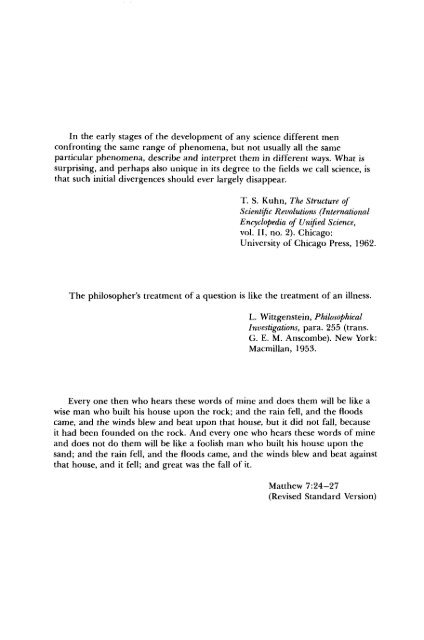
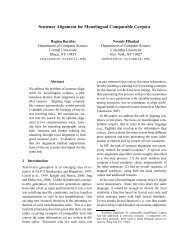
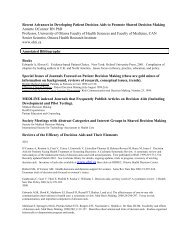
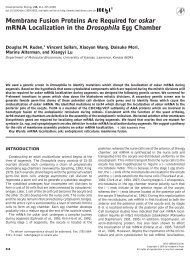
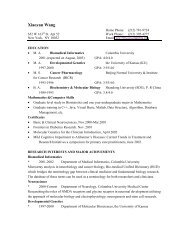
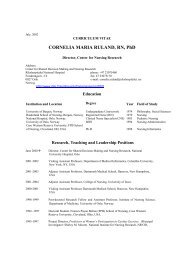
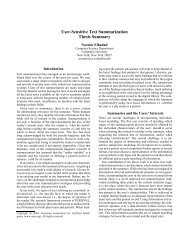
![[1998] Automated Knowledge Extraction from the UMLS - People ...](https://img.yumpu.com/31540760/1/190x245/1998-automated-knowledge-extraction-from-the-umls-people-.jpg?quality=85)
